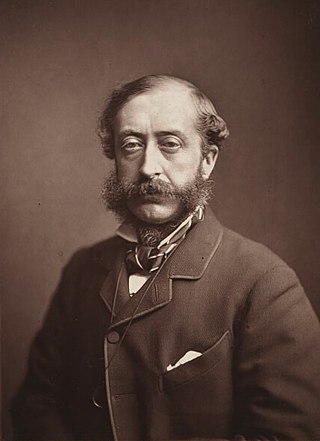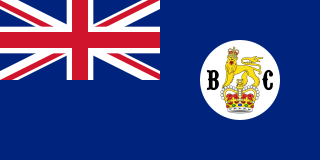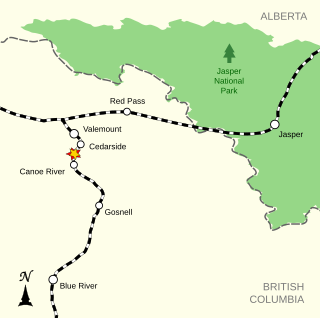Related Research Articles

The Canadian Pacific Railway, also known simply as CPR or Canadian Pacific and formerly as CP Rail (1968–1996), was a Canadian Class I railway incorporated in 1881. The railway was owned by Canadian Pacific Railway Limited, which began operations as legal owner in a corporate restructuring in 2001.

Sir Charles Tupper, 1st Baronet,, M.D. was a Canadian Father of Confederation who served as the sixth prime minister of Canada from May 1 to July 8, 1896. As the premier of Nova Scotia from 1864 to 1867, he led Nova Scotia into Confederation. He briefly served as the Canadian prime minister, from seven days after parliament had been dissolved, until he resigned on July 8, 1896, following his party's loss in the 1896 Canadian federal election. He is the only medical doctor to have ever held the office of prime minister of Canada and his 68-day tenure as prime minister is the shortest in Canadian history.

The Pacific Scandal was a political scandal in Canada involving large sums of money being paid by private interests to the Conservative party to cover election expenses in the 1872 Canadian federal election, to influence the bidding for a national rail contract. As part of British Columbia's 1871 agreement to join the Canadian Confederation, the federal government had agreed to build a transcontinental railway linking the seaboard of British Columbia to the eastern provinces.

Canadian Confederation was the process by which three British North American provinces—the Province of Canada, Nova Scotia, and New Brunswick—were united into one federation called the Dominion of Canada, on July 1, 1867. Upon Confederation, Canada consisted of four provinces: Ontario and Quebec, which had been split out from the Province of Canada, and the provinces of Nova Scotia and New Brunswick. Over the years since Confederation, Canada has seen numerous territorial changes and expansions, resulting in the current number of ten provinces and three territories.

Events from the year 1880 in Canada.

Henry Howard Molyneux Herbert, 4th Earl of Carnarvon,, known as Lord Porchester from 1833 to 1849, was a British politician and a leading member of the Conservative Party. He was twice Secretary of State for the Colonies and also served as Lord Lieutenant of Ireland.

The history of British Columbia covers the period from the arrival of Paleo-Indians thousands of years ago to the present day. Prior to European colonization, the lands encompassing present-day British Columbia were inhabited for millennia by a number of First Nations.

George Anthony "Boomer" Walkem was a British Columbian politician and jurist.

Robert Beaven, son of James Beaven, was a British Columbia politician and businessman. Beaven moved to British Columbia from Toronto, where he had been educated at Upper Canada College, because of the gold rush. He entered business in Victoria, which was then the capital of the Colony of Vancouver Island. After the colony's union with British Columbia, Beaven became involved with politics as secretary of Amor De Cosmos' Confederation League which advocated that the colony enter Canadian Confederation.

John Robson was a Canadian journalist and politician, who served as the ninth premier of British Columbia.

The Island Rail Corridor, previously the Esquimalt & Nanaimo Railway, is a dormant railway operation on Vancouver Island and is the only remaining railway there after the closure of the Englewood Railway in November 2017. The Island Corridor Foundation owns the former Esquimalt & Nanaimo Railway corridor. The railway line is 225 kilometres (140 mi) in length from Victoria to Courtenay, known as the Victoria Subdivision, with a branch line from Parksville to Port Alberni, known as the Port Alberni Subdivision, of 64 kilometres (40 mi), for a total 289 kilometres (180 mi) of mainline track. In 2006, the Island Corridor Foundation acquired the railway's ownership from the Canadian Pacific Railway.
The 1875 British Columbia general election was held in 1875. Many of the politicians in the House had served with the Legislative Council or Assembly or the Executive Council, or had otherwise been stalwarts of the colonial era - some supporters of Confederation, others not. Some were ranchers or mining bosses from the Interior, others were colonial gentry from the Island and New Westminster, and others direct arrivals from Britain, Ireland or "Canada", which was still considered a different place not only in the minds of the politicians but in the language used in Hansard during this period.

The Colony of Vancouver Island, officially known as the Island of Vancouver and its Dependencies, was a Crown colony of British North America from 1849 to 1866, after which it was united with the mainland to form the Colony of British Columbia. The united colony joined Canadian Confederation, thus becoming part of Canada, in 1871. The colony comprised Vancouver Island and the Gulf Islands of the Strait of Georgia.

The Colony of British Columbia was a British Crown Colony that resulted from the 1866 merger of two British colonies, the Colony of Vancouver Island and the mainland Colony of British Columbia. The united colony existed until its incorporation into Canadian Confederation in 1871 as the Province of British Columbia.

Post-Confederation Canada (1867–1914) is history of Canada from the formation of the Dominion to the outbreak of World War I in 1914. Canada had a population of 3.5 million, residing in the large expanse from Cape Breton to just beyond the Great Lakes, usually within a hundred miles or so of the Canada–United States border. One in three Canadians was French, and about 100,000 were aboriginal. It was a rural country composed of small farms. With a population of 115,000, Montreal was the largest city, followed by Toronto and Quebec at about 60,000. Pigs roamed the muddy streets of Ottawa, the small new national capital.

John Sebastian Helmcken was a British Columbia physician who played a prominent role in bringing the province into Canadian Confederation. He was also the founding president of the British Columbia Medical Association.
John Ash was a Canadian physician and politician.
The 1st Legislative Assembly of British Columbia sat from 1871 to 1875. The members were elected in the British Columbia general election held in October 1871. John Foster McCreight was called upon to form a cabinet. In December 1872, the government was defeated on a confidence motion and Amor De Cosmos subsequently formed a new cabinet. After De Cosmos was elected to the House of Commons in February 1874, George A. Walken became premier.

The Canoe River train crash occurred on November 21, 1950, near Valemount in eastern British Columbia, Canada, when a westbound troop train and the eastbound Canadian National Railway (CNR) Continental Limited collided head-on. The collision killed 21 people: 17 Canadian soldiers en route to the Korean War and the two-man locomotive crew of each train.